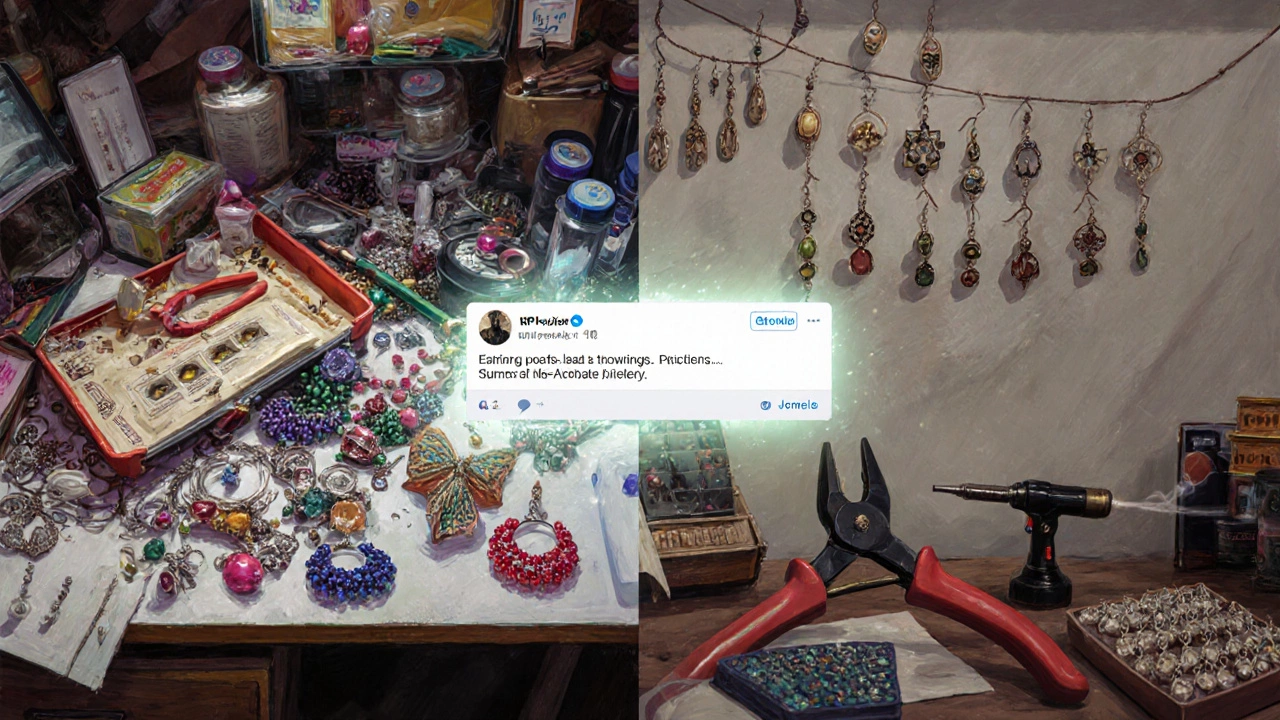Jewelry Business Profit Calculator
Calculate Your Potential Earnings
Is selling jewelry worth it? If you’ve ever spent an evening crafting earrings from a jewelry making kit, wondering if you could turn that into real income, you’re not alone. Thousands of people in India-especially in cities like Mumbai, Jaipur, and Bangalore-are picking up beadwork, wire wrapping, and resin casting after seeing success stories online. But here’s the truth most tutorials don’t tell you: making jewelry and selling it are two completely different skills. One takes patience. The other takes strategy.
How much do handmade jewelry sellers actually make?
Let’s cut through the hype. On Instagram or Etsy, you see influencers selling delicate gold-plated necklaces for ₹2,500 and calling it a "side hustle." But what they don’t show you is the cost behind that ₹2,500 price tag. A single necklace might use ₹400 in beads, ₹150 in findings, ₹80 in packaging, and ₹200 in platform fees and ads. That leaves you with ₹1,670 before taxes, labor, and time.
Time is the hidden cost. If it takes you three hours to make one piece and you sell five a week, you’re working 15 hours for ₹8,350. That’s ₹557 per hour. Sounds good? Now compare that to a part-time job in Mumbai paying ₹200-₹250/hour with benefits. Suddenly, the math changes.
But here’s the twist: top sellers aren’t making one-off pieces. They’re creating collections. A consistent line of 8-12 designs, repeated in batches of 20-30 units, cuts material costs by 40%. Buying beads in bulk from suppliers in Surat or Jaipur drops your cost per earring from ₹120 to ₹50. That’s the difference between breaking even and turning a profit.
What kind of jewelry sells best in 2025?
Not all jewelry is created equal when it comes to sales. In India, demand has shifted. Traditional temple jewelry still sells during wedding season, but it’s seasonal and requires high upfront investment. What’s growing fast? Minimalist pieces that blend cultural roots with modern style.
Best-selling items in 2025 include:
- Small gold-plated jhumkas with matte finishes (₹800-₹1,500)
- Stackable thin bangles in oxidized silver (₹600-₹1,200)
- Personalized mangalsutra pendants with initials (₹1,800-₹3,000)
- Resin earrings shaped like peacocks or lotus flowers (₹700-₹1,400)
These items work because they’re affordable, Instagram-friendly, and carry emotional meaning without being overly traditional. Customers aren’t just buying jewelry-they’re buying identity. A woman in Pune doesn’t want a ₹15,000 gold set. She wants a ₹1,200 bangle she can wear to her office and still feel connected to her roots.
Where do you actually sell jewelry?
Selling jewelry isn’t just about listing it online. It’s about where you list it-and how.
Etsy and Amazon Handmade are global, but they charge 6.5% + payment processing fees. For Indian sellers, Instagram and WhatsApp are still the most profitable channels. Why? No platform fees. No middlemen. You talk directly to the buyer. A customer in Hyderabad sees your post, DMs you, and pays via UPI. You ship via Delhivery. Profit margin? 70-80%.
But here’s the catch: Instagram doesn’t grow itself. You need consistency. Post 3-4 times a week. Show behind-the-scenes clips of you making the pieces. Share customer photos. Use local hashtags like #MumbaiJewelryMaker or #HyderabadHandmade. Don’t just post product shots. Tell stories. Why did you choose that color? Who inspired this design? People buy from people.
Local markets like Crawford Market in Mumbai or Johari Bazaar in Jaipur still matter. Renting a small stall for ₹5,000/month lets you test designs without inventory risk. If a piece sells out in two weeks, scale it online. If it sits, kill it. No emotional attachment.

What jewelry making kits actually get you
Those ₹999 jewelry making kits on Amazon? They’re great for learning. They include pliers, beads, clasps, and instructions. Perfect for beginners. But here’s what they don’t tell you: they’re not designed for production.
Kit beads are low-quality. The wire snaps. The clasps rust. You can’t scale a business on kit materials. After your third cracked earring, you’ll realize you need to buy bulk components from trusted suppliers. Look for wholesalers on IndiaMART or visit local markets like Lalbaug in Mumbai. Pay ₹300 for 100 gold-plated jump rings instead of ₹20 each from a kit.
Think of the kit as your training wheels. Once you can make a clean loop without cutting your finger, upgrade to professional tools: nylon-jaw pliers, bead mats, and a jewelry torch for soldering. These cost ₹4,000-₹6,000 upfront. But they’ll last five years. That’s a better investment than buying ten more kits.
Hidden costs most beginners ignore
You think the biggest cost is materials. It’s not.
Here’s what actually eats your profit:
- Photography: Your phone camera isn’t enough. A good ring light and white backdrop cost ₹2,500. Without good photos, your jewelry looks cheap-even if it’s handmade with care.
- Packaging: A ₹5 kraft box with tissue and a thank-you card costs ₹12-₹15 per unit. But it turns a sale into an experience. Customers are more likely to leave a review or refer friends.
- Shipping: Free shipping sounds generous, but it’s a trap. Charge ₹50-₹80 for shipping. Most customers expect it. If you absorb it, you’re losing ₹200-₹300 per order.
- Taxes: If you make over ₹20 lakh/year, GST kicks in at 5%. Track every rupee. Use a simple app like Khatabook. Don’t wait until April to panic.
One seller in Ahmedabad made ₹18 lakh last year. She spent ₹1.2 lakh on ads, ₹80,000 on packaging, and ₹2.1 lakh on materials. Her net profit? ₹3.9 lakh. That’s 22% margin. Not bad-but only after she stopped giving away free shipping and started charging for custom designs.

When selling jewelry is NOT worth it
There are times when you should walk away.
If you’re doing this because you think it’s "easy money," you’ll quit in three months. If you hate marketing, you’ll struggle. If you can’t handle customers asking for discounts or returning items because "it didn’t match my dress," you’ll burn out.
Also, don’t start if you’re trying to replace a full-time income right away. Most jewelry businesses take 12-18 months to become stable. The first six months? You’ll make ₹5,000-₹10,000/month. That’s not enough to live on unless you have other income.
And if you’re copying designs from big brands? Stop. You’ll get flagged on Instagram. You’ll get sued. Originality isn’t just ethical-it’s your only competitive edge.
Is it worth it? The real answer
Is selling jewelry worth it? Yes-if you treat it like a business, not a hobby.
It’s worth it if you enjoy the process: choosing colors, fixing broken chains, hearing a customer say, "This is exactly what I’ve been looking for."
It’s worth it if you’re okay with slow growth, learning photography, managing UPI payments, and packing orders on Sunday nights.
It’s worth it if you’re building something that reflects your culture, your style, your story.
But if you want quick cash, easy money, or to become rich overnight? Look elsewhere.
The jewelry business doesn’t reward luck. It rewards consistency. It rewards people who show up, even when no one’s buying. Who keep improving their craft, even when the algorithm ignores them. Who treat every customer like they’re the only one.
That’s what makes it worth it.
Can I start selling jewelry with just a jewelry making kit?
Yes, you can start with a kit to learn the basics-making loops, attaching clasps, arranging beads. But you can’t scale a business with kit materials. Kit beads are low quality and expensive per unit. To make real profit, you need to buy bulk components from wholesalers like those in Surat or Jaipur. Use the kit to practice, then upgrade to professional supplies.
How much money do I need to start a small jewelry business?
You can start with as little as ₹10,000-₹15,000. This covers your first batch of materials (beads, wires, findings), a basic ring light for photos, packaging supplies, and a small ad budget on Instagram. Avoid spending on expensive tools upfront. Focus on making 10-15 pieces you can sell. Reinvest profits into better tools and bulk materials.
What’s the most profitable type of jewelry to sell in India?
Minimalist pieces that blend tradition with modern style sell best. Think small gold-plated jhumkas, stackable oxidized silver bangles, personalized mangalsutra pendants, and resin earrings with cultural motifs. These cost ₹500-₹1,500 to make and sell for ₹1,200-₹3,000. They appeal to young urban buyers who want meaning without bulk.
Should I sell on Instagram or Etsy?
For Indian sellers, Instagram and WhatsApp are more profitable. You avoid platform fees (Etsy takes 6.5% + payment processing), and customers trust direct messaging. Use Instagram to showcase your work and drive traffic to WhatsApp for sales. Etsy works better if you’re targeting international buyers, but shipping costs and returns make it harder to profit unless you’re selling high-ticket items.
Do I need to register my jewelry business or pay taxes?
If you make under ₹20 lakh/year, you don’t need GST registration. But you still need to track income and expenses for tax filing. Once you cross ₹20 lakh, GST at 5% applies. Use apps like Khatabook or Zoho Books to log sales and expenses. Even if you’re small, keeping records protects you if someone questions your income later.
How long does it take to make money selling jewelry?
Most sellers see their first ₹5,000-₹10,000 in sales within 2-3 months. But building a steady income takes 12-18 months. The first six months are about learning what sells, improving photos, and building trust. Don’t expect to quit your job before year one. Treat it like a side hustle until you have consistent monthly sales of ₹50,000+.



